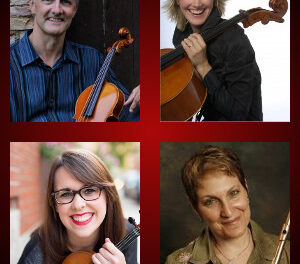André Raphel Smith, celebrated conductor of the Wheeling Symphony Orchestra and an active guest conductor here and abroad, took the podium for the final concert of the season by Brevard Music Center’s Transylvania Symphony Orchestra. Present in Whittington-Pfohl Auditorium were students’ family members as well as concertgoers who have gotten to know the orchestra so well by now they can name the individual players. Brandon Garbot and Annie Bender, soloists earlier this week in the Bach Concerto in D minor for two violins, strings, and continuo, took turns as concertmaster. The program was a selection of sure-fire classical hits guaranteed to put the orchestra through its paces.
Leading the program was Rossini’s Overture to La gazza ladra (The Thieving Magpie). Bass and snare drum rolls from either side of the orchestra referenced both the army and the tattoos played at executions, elements of the opera’s plot about a young serving girl who is nearly executed for theft, but spared when her magpie is discovered with the stolen goods. The orchestra as a whole was impressive, but the various wind soloists (especially oboe, piccolo, and clarinet) were outstanding. Smith conducted the work mostly in large beat units, and the ensemble was adept at not only following, but also making exceptional music.
Next came Ottorino Respighi’s Ancient Airs and Dances Suite No. 3, a compilation of charming melodies drawn from collections of lute music published in the late nineteenth century by Italian musicologist Oscar Chilesotti. The first movement “Anon.: Italiana,” a slow and graceful dance in triple meter, set a sophisticated and dignified tone worlds away from Rossini’s overture. The second movement, “Jean-Baptiste Besard: Arie di corte,” is like a suite within a suite, containing a series of four melodies in which the first returns at the end. The third movement “Anon.: Siciliana,” an elegant sort of theme and variations, was based on an anonymous “Spagnoletta,” a melody often set in Spain and Italy in the seventeenth century. The final “Lodovico Roncalli: Passacaglia,” was a variation set over a repeating bass line with catchy meter and tempo changes. This strings-only piece showed how far the strings have come just this season — their sound was full and beautifully rounded — “honeyed” — with sensitive styling for each movement, some of the best playing of the evening.
At intermission Marcia Millar, President of the Brevard Music Center Association, acknowledged the 30th anniversary of the auxiliary organization and the work done throughout the year by an army of volunteers. A check for $60,000 was presented to John Candler, the Center’s President and CEO.
The final work on the concert was Berlioz’s Symphonie fantastique, an enormous piece by any reckoning for such a young ensemble. Leonard Bernstein had once assessed this quasi-autobiographical work as “a psychedelic musical trip where you wind up screaming at your own funeral.” The score is rife with myriad special effects providing a sound track to the program, the underlying story of obsessive love, rejection, psychotic brooding, death, and hell itself. Berlioz called the work’s signature melody that he associates with the beloved an idée fixe, a psychiatric term for obsession. The tune is present in various guises in each of the movements, and morphs from the adorable to the diabolical.
The first movement “Rêveries, passions” is a musical depiction of love at first blush. We hear the idée fixe first in the violins as a long melody with upward leaps, like those of the hopeful heart. The second movement “Un Bal” depicts not so much a dance as a swirl of emotions, as he can’t get her out of his mind. There were four harps, not the prescribed two! The idée fixe here is in fragments in the winds. The third movement “Scène aux champs” (Scene in the Country) features a ranz des vaches (Herdsman’s Song), written as a dialogue between an English horn and an off-stage oboist (kudos to those players). The conflicting emotions heighten — he’s hopeful, longing, but then filled with fear of deception. The peace of the pastoral duet gives way to a storm, then a reprise of the ranz des vaches that is answered by silence.
The final two movements, “Marche au supplice” (March to the Scaffold) and “Songe d’une Nuit du Sabbat” (Dream of a Witches’ Sabbbath) are musical renditions of his worst nightmares. Rendered senseless by imbibing opium, he dreams of his own execution for her murder and a “frightful troop of ghosts, sorcerers, monsters of every kind,” including his beloved, who have come for his funeral. The orchestra did an incredible job with these two movements. The winds, brass, and percussion, singly and together, executed the trickiest passages at warp speed. Moreover, the energy and tidal wave of enthusiasm generated by the performance was palpable and infectious, a fitting ending to a tremendous season.











